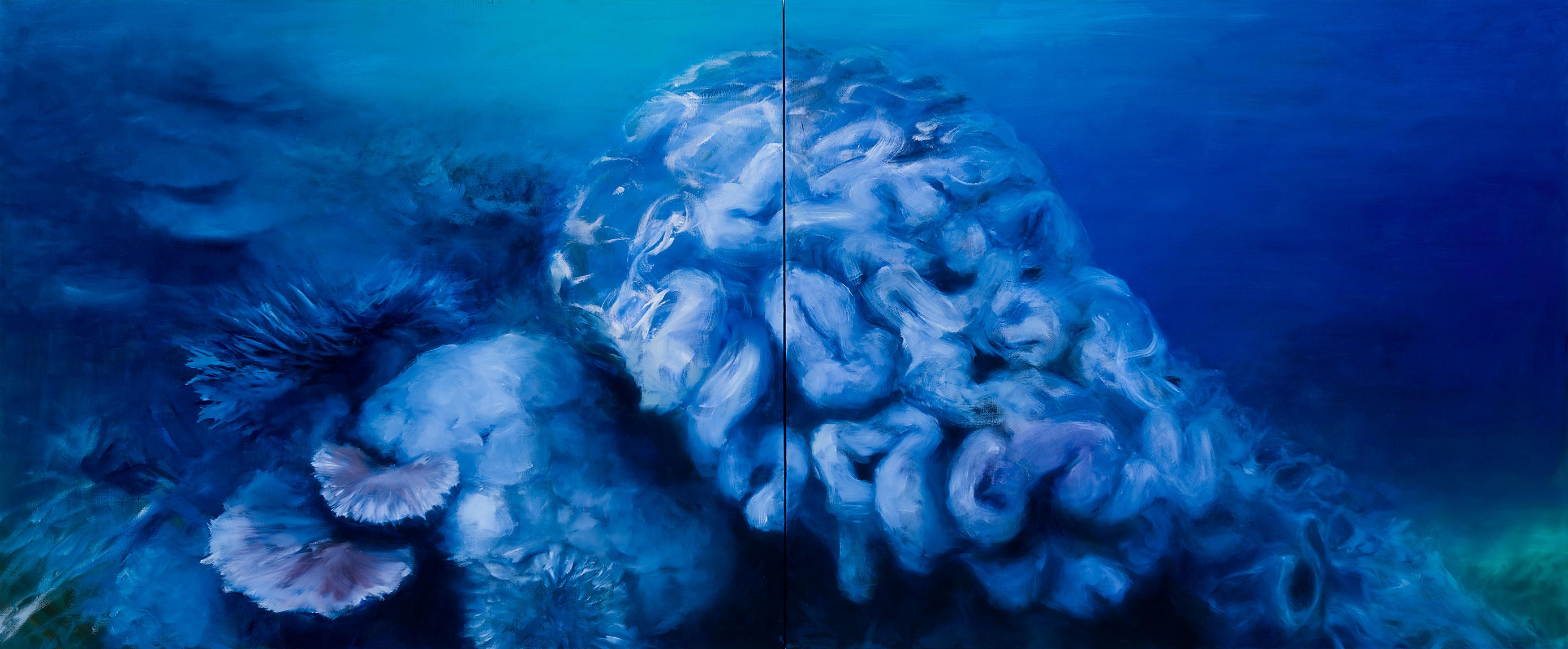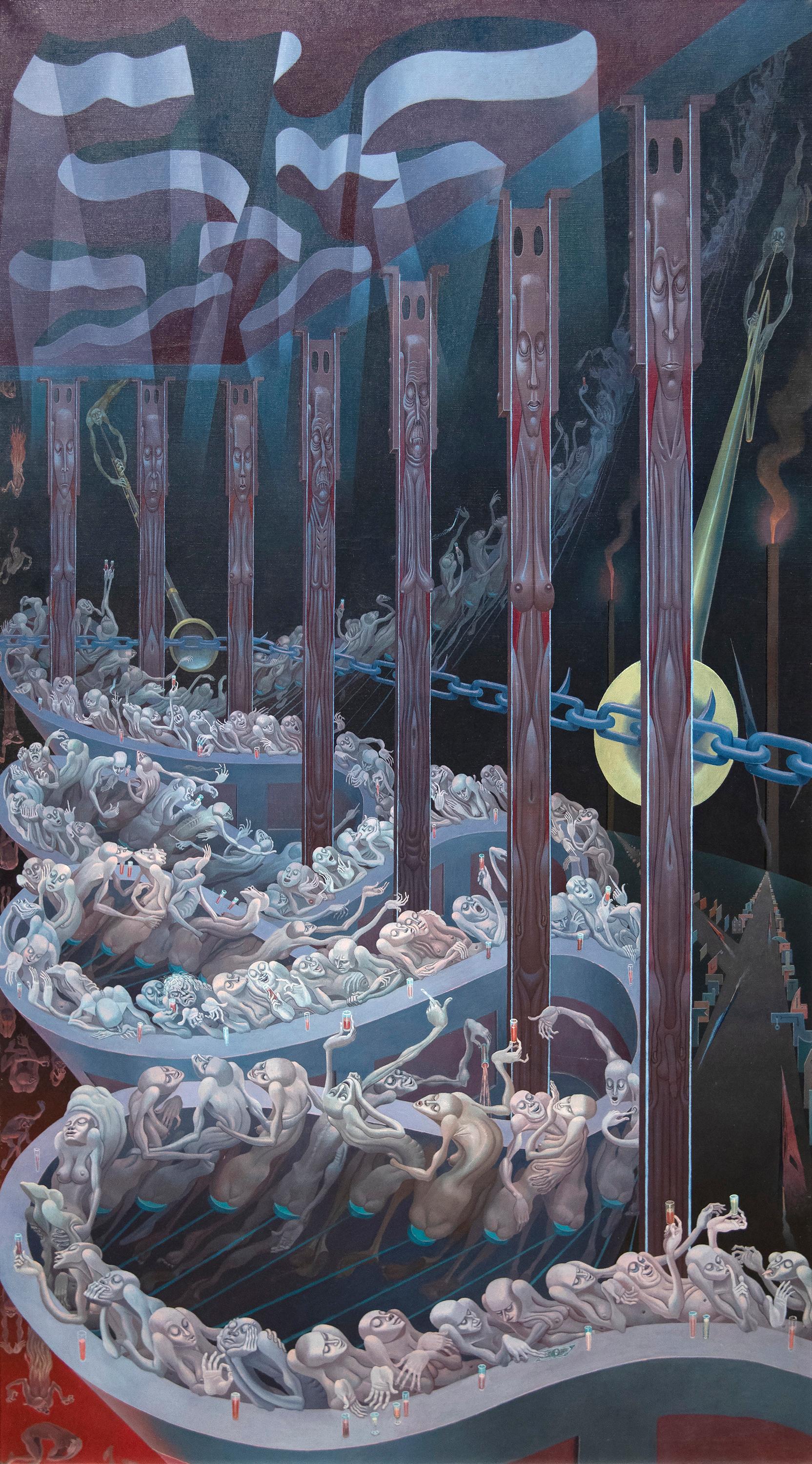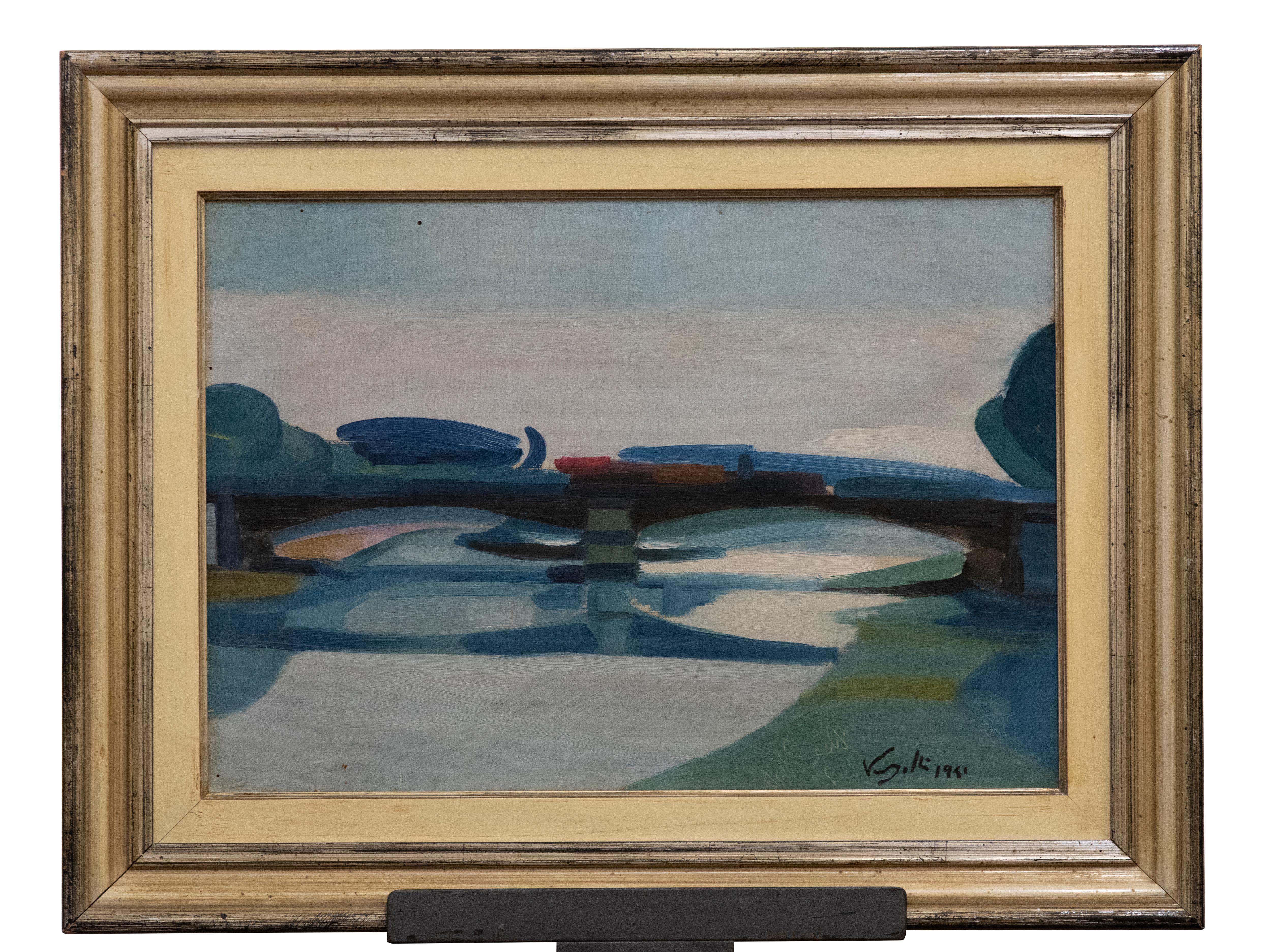Items Similar to Evening Glow by Swedish Artist Gustav Andreas Gehlin
Want more images or videos?
Request additional images or videos from the seller
1 of 10
Gustav GehlinEvening Glow by Swedish Artist Gustav Andreas Gehlinc. 1930
c. 1930
About the Item
Evening Glow by Gustav Andreas Gehlin
This exquisite oil painting, "Evening Glow," is a captivating work by the Swedish artist and photographer Gustav Andreas Gehlin. He studied under Carl Malmberg at the Västerås Technical School from 1913 to 1916, thereafter honing his craft through self-study and inspirational journeys to Norway and the South of France. A regular contributor from 1926 to 1951 at the annual exhibitions of Västerås artists and showcased at Liljevalchs Art Hall in Stockholm, Gehlin's artistry was well recognized.
Gehlin's work, including "Evening Glow," is celebrated for its subdued, atmospheric landscapes and still lifes, crafted in oil or watercolor. This painting perfectly encapsulates his mastery of mood, with its serene depiction of a landscape at dusk. The mellowed sky, painted in warm hues of yellow and orange melting into cooler blues, contrasts harmoniously with the dark silhouette of the forest. A tranquil body of water mirrors the sky's twilight beauty, enhancing the painting's overall tranquility. Gehlin's skillful use of light and shadow evokes a deep sense of calm and reflection.
Accompanied by a finely crafted new gold frame the is included in the purchase.
oil on canvas
signed G.Gehlin
Unframed 33 x 46.5 cm (13 x 18.3 inches)
Framed 43 x 57 cm (16.9 x 22.4 inches)
Provenance:
A private collection, Stockholm.
- Creator:Gustav Gehlin (1887 - 1970, Swedish)
- Creation Year:c. 1930
- Dimensions:Height: 13 in (33 cm)Width: 18.12 in (46 cm)
- Medium:
- Period:
- Condition:The surface is recently cleaned. Overall very good condition. New gold frame from 2024.
- Gallery Location:Stockholm, SE
- Reference Number:1stDibs: LU1445213839902
About the Seller
5.0
Platinum Seller
These expertly vetted sellers are 1stDibs' most experienced sellers and are rated highest by our customers.
Established in 2020
1stDibs seller since 2020
120 sales on 1stDibs
Typical response time: <1 hour
Associations
International Confederation of Art and Antique Dealers' Associations
- ShippingRetrieving quote...Ships From: Stockholm, Sweden
- Return PolicyA return for this item may be initiated within 2 days of delivery.
More From This SellerView All
- Summer Day on the West Coast of Sweden by Swedish Impressionist Alfred WahlbergLocated in Stockholm, SEAlfred Wahlberg was a distinguished Swedish landscape painter whose career spanned Germany, France, and Sweden. During his early years, he resided in D...Category
Late 19th Century Impressionist Landscape Paintings
MaterialsCanvas, Oil
- Twilight Landscape with Windmill and Church, 1891Located in Stockholm, SE"Twilight Landscape with Windmill and Church" is a captivating work by Swedish artist Albert Larsson, painted in 1891 when Larsson was 22 years old. The painting captures a landscape steeped in the quietude of dusk, with a sky ablaze in hues of red and orange, signalling the end of the day. The silhouettes of trees are rendered with astonishing detail against the twilight sky, showcasing Larsson's early mastery of light and shadow. Dominating the pastoral scene is a traditional windmill, its blades stilled against the sky, alongside the spire of a church that pierces the horizon. These structures, together with the meticulously painted trees, are testaments to the human presence within the natural world, suggesting a harmony between the two. A notable feature is the small water-filled furrow in the field, which catches the fading light of the sky, creating a pathway of reflection leading the eye through the composition. This detail highlights Larsson's skill in using light to draw attention to elements within his paintings. Albert Larsson, born on November 4, 1869, in Malmö and passing on August 31, 1952, in Lund, was an artist deeply influenced by his education in Copenhagen at the Art Academy and later at Peder Severin Krøyer...Category
1890s Romantic Landscape Paintings
MaterialsCanvas, Oil
- Two Paintings in One, Art Nouveau Landscape And Winter Landscape. Oak FrameLocated in Stockholm, SEAlfred Ekstam, a renowned artist from Mangskog, Sweden, is known for his exquisite landscape paintings. We are excited to present this painting by Ekstam, which is extra special because it is painted on both sides, offering two beautiful landscapes in one, with a reversible frame that can be turned over without having to take it down from the wall. On one side, you will be mesmerized by a stunning Art Nouveau landscape with a purple tone, featuring a mountain in the background, a lake, and trees in the foreground with shades of yellow, red, and green. On the other side, you will see a winter landscape with five red houses, likely to be Ekstam's own farm in Knaggen. The winter scene showcases sun rays shining down on the houses...Category
1910s Art Nouveau Landscape Paintings
MaterialsOil, Canvas
- Shipping in Stormy Waters, Attributed to Italian Artist Francesco GuardiBy Francesco GuardiLocated in Stockholm, SEThe splendour of the tragic sea Francesco Guardi and maritime painting in Venetian art No Venetian painter was a stranger to the sea. After all, Venice was not only one of the most prominent ports of the Mediterranean, but indeed a city literally submerged in the ocean from time to time. Curiously however, the famous Venetian school of painting showed little interest in maritime motifs, favouring scenes from the iconic architecture of the city rather than seascapes. That is why this painting is a particularly interesting window into not only the painter Francesco Guardi himself – but to the significance of the element of water in art history, in absence as well as in the centre of attention. Whether it be calm, sunny days with stunning views of the palaces alongside the canals of Venice or – more rarely – stormy shipwrecking tragedies at sea, water as a unifying element is integral to the works of painter Francesco Guardi (1712–1793). During his lifetime, Venetian art saw many of its greatest triumphs with names like Tiepolo or Canaletto gaining international recognition and firmly establishing Venice as one of the most vibrant artistic communities of Europe. While the city itself already in the 18th century was something of an early tourist spot where aristocrats and high society visited on their grand tour or travels, the artists too contributed to the fame and their work spread the image of Venice as the city of romance and leisure to an international audience, many of whom could never visit in person. Still today, the iconic image of Venice with its whimsical array of palaces, churches and other historic buildings is much influenced by these artists, many of whom have stood the test of time like very well and remain some of the most beloved in all of art history. It was not primarily subtility, intellectual meanings or moral ideals that the Venetian art tried to capture; instead it was the sheer vibrancy of life and the fast-paced city with crumbling palaces and festive people that made this atmosphere so special. Of course, Venice could count painters in most genres among its residents, from portraiture to religious motifs, history painting and much else. Still, it is the Vedutas and views of the city that seems to have etched itself into our memory more than anything else, not least in the tradition of Canaletto who was perhaps the undisputed master of all Venetian painters. Born into his profession, Francesco lived and breathed painting all his life. His father, the painter Domenico Guardi (1678–1716) died when Francesco was just a small child, yet both he and his brothers Niccolò and Gian Antonio continued in their fathers’ footsteps. The Guardi family belonged to the nobility and originated from the mountainous area of Trentino, not far from the Alps. The brothers worked together on more challenging commissions and supported each other in the manner typical of family workshops or networks of artists. Their sister Maria Cecilia married no other than the artist Giovanni Battista Tiepolo himself, linking the family to the most renowned Venetian name of the time. During almost a decade, Guardi worked in the studio of Michele Giovanni Marieschi, sometimes simply known as Michiel, a painted similar in both style and motif. Canaletto is, however, the artist Guardi is most often compared to since they shared a mutual fascination for depicting the architecture and cityscape of Venice. During the course of his career, Guardi tried his hand in many different genres. He was as swift in painting landscapes, Vedutas of Venice, sacred motifs, interiors and architectural compositions as he was in a number of other motifs. His style is typical of the Venetian school but also distinct and personal once we look a little closer. There is an absolute certainty in the composition, the choice of which sometimes feels like that of a carefully calculated photograph – yet it is also very painterly, in the best sense of the word: fluid, bold, sensitive and full of character. The brushwork is rapid, intense, seemingly careless and extraordinarily minute at the same time; fresh and planned in a very enjoyable mixture. His interiors often capture the breath-taking spacious glamour of the palaces and all their exquisite decor. He usually constructed the motif through remarkably simple, almost spontaneous yet intuitively precise strokes and shapes. The result was a festive, high-spirited atmospheric quality, far away from the sterile and exact likeness that other painters fell victim to when trying to copy Canaletto. The painting here has nothing of the city of Venice in it. On the contrary, we seem to be transported far away into the solitary ocean, with no architecture, nothing to hold on to – only the roaring sea and the dangerous cliffs upon which the ships are just moments away from being crushed upon. It is a maritime composition evoking both Flemish and Italian precursors, in the proud tradition of maritime painting that for centuries formed a crucial part of our visual culture. This genre of painting is today curiously overlooked, compared to how esteemed and meaningful it was when our relationship to the sea was far more natural than it is today. When both people and goods travelled by water, and many nations and cities – Venice among them – depended entirely on sea fare, the existential connection to the ocean was much more natural and integrated into the imagination. The schools and traditions of maritime art are as manifold as there are countries connected to the sea, and all reflect the need to process the dangers and wonders of the ocean. It could symbolize opportunity, the exciting prospects of a new countries and adventures, prospering trade, beautiful scenery as well as war and tragedy, loss of life, danger and doom. To say that water is ambivalent in nature is an understatement, and these many layers were something that artists explored in the most wondrous ways. Perhaps it takes a bit more time for the modern eye to identify the different nuances and qualities of historic maritime paintings, they may on first impression seem hard to differentiate from each other. But when allowing these motifs to unfold and tell stories of the sea in both fiction and reality – or somewhere in between – we are awarded with an understanding of how the oceans truly built our world. In Guardi’s interpretation, we see an almost theatrically arranged shipwrecking scene. No less than five ships are depicted right in the moment of utter disaster. Caught in a violent storm, the waves have driven them to a shore of sharp cliffs and if not swallowed by the waves, crushing against the cliffs seems to be the only outcome. The large wooden ships are impressively decorated with elaborate sculpture, and in fact relics already during Guardi’s lifetime. They are in fact typical of Dutch and Flemish 17th century ships, giving us a clue to where he got the inspiration from. Guardi must have seen examples of Flemish maritime art, that made him curious about these particular motifs. One is reminded of Flemish painters like Willem van de Velde and Ludolf Backhuysen, and this very painting has indeed been mistakenly attributed to Matthieu van Plattenberg...Category
18th Century Old Masters Landscape Paintings
MaterialsCanvas, Oil
- Winter Scene With Figures on the Ice by Bengt Nordenberg, Signed, Free ShippingLocated in Stockholm, SEBengt Nordenberg (1822-1902) Swedish Winter Scene With Figures on the Ice oil on canvas signed and dated B. Nordenberg 18(4?)6 canvas size 10.90 x 13.89 inches (27.7 x 35.3 cm) fr...Category
19th Century Figurative Paintings
MaterialsOil, Canvas
- A Soldier Blowing the Trumpet by French Artist Charles Bouchez, Oil on CanvasLocated in Stockholm, SECharles Bouchez (1811-1882) French A Soldier Blowing the Trumpet oil on canvas signed and dated ch. Bouchez 1842 canvas dimensions 6.29 x 4.13 inches (16 x 10.5 cm) frame 10.23 x 7...Category
1840s French School Figurative Paintings
MaterialsOil, Canvas
You May Also Like
- "Ebbing Reef" Corals, Large Scale Contemporary Seascape Oil Painting (deep blue)By Karen MarstonLocated in New York, NY60"x144" large scale painting, oil on canvas, created on two joined canvases. The deep blue palette gives a sense of underwater space in this grand depiction of coral reefs. Artist, Karen Marston presents this endangered species in a grand scale to show its beauty and importance to our environment. Karen Marston is a painter living and working in Brooklyn, NY. Her work has been seen in a number of solo exhibitions in New York City. In addition to her 2018 show Harbingers, at the Owen James Gallery in Soho, other recent solos include: 2017’s To Embrace the Whole Sky with the Mind, at Station Independent Projects on the Lower East Side, Demeter’s Wrath in 2016 at the Owen James Gallery and Storm Watch...Category
2010s Contemporary Landscape Paintings
MaterialsOil, Canvas
- "Valencian Flower Pickers ", Early 20th Century Oil on Canvas by José MongrellLocated in Madrid, ESJOSÉ MONGRELL Spanish, 1870 - 1937 VALENCIAN FLOWER PICKERS signed “J. Mongrell” lower left oil on canvas 29-1/4 x 45 inches (74 x 114 cm.) framed: 42-3/...Category
1910s Realist Figurative Paintings
MaterialsCanvas, Oil
- American Street SceneBy Irving NormanLocated in Palm Desert, CAA painting by Irving Norman. "American Street Scene" is a macabre social surrealism city scape, oil on canvas in a bold palette of reds, blues, and yellows by artist Irving Norman. T...Category
Mid-20th Century Post-War Figurative Paintings
MaterialsCanvas, Oil
- BacchanalBy Irving NormanLocated in Palm Desert, CAA painting by Irving Norman. "Bacchanal" is a macabre social surrealism painting, oil on canvas in a dark palette of reds, blues, and blacks by artist Irving Norman. The artwork is u...Category
Mid-20th Century Post-War Figurative Paintings
MaterialsCanvas, Oil
- Mountain Mystery - Oil Paint by Elena Mardashova - 2023Located in Roma, ITOriginal oil painting on canvas 70X50 cm, entitled Mountain Mystery. Excellent condition.Category
2010s Contemporary Figurative Paintings
MaterialsCanvas, Oil
- Ponte Garibaldi, Rome - Oil on Canvas by A. Vangelli - 1941By Antonio VangelliLocated in Roma, ITPonte Garibaldi is an original oil on canvas realized by the Italian artist Antonio Vangelli (Rome, 1917 – Rome, 2003) in 1941. Hand-signed and dated by the artist on the lower righ...Category
1940s Figurative Paintings
MaterialsCanvas, Oil
Recently Viewed
View AllMore Ways To Browse
Antique Glow
Antique Swedish Paintings
Swedish School Oil Painting
Evening Shadows
Landscape Oil Painting From Sweden
Antique Silhouette Frames
Glow In The Dark Painting
Gustav Oil Paintings
Antique Hone
Antique Framed Silhouette
Antique Framed Silhouettes
Antique Swedish Oil Painting
Evening Mood
Antique Silhouette Paintings
Swedish Still Life Oil Painting
Evening Twilight
Norwegian Mirror
Water Cooler




